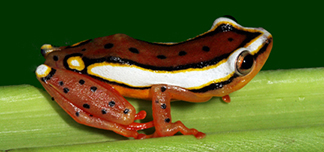| Publication Type: | Journal Article |
| Year of Publication: | 2006 |
| Authors: | D. R. Frost, Grant, T., Faivovich, J., Bain, R. H., Haas, A., Haddad, C. F. B., De Sa, R. O., Channing, A., Wilkinson, M., Donnellan, S. C., Raxworthy, C. J., Campbell, J. A., Blotto, B. L., Moler, P., Drewes, R. C., Nussbaum, R. A., Lynch, J. D., Green, Dm, Wheeler, W. C. |
| Journal: | Bulletin of the American Museum of Natural History |
| Volume: | 297 |
| Pagination: | 8-291 |
| Abstract: | The evidentiary basis of the currently accepted classification of living amphibians is discussed and shown not to warrant the degree of authority conferred on it by use and tradition. A new taxonomy of living amphibians is proposed to correct the deficiencies of the old one. This new taxonomy is based on the largest phylogenetic analysis of living Amphibia so far accomplished. We combined the comparative anatomical character evidence of Haas (2003) with DNA sequences from the mitochondrial transcription unit HI (12S and 16S ribosomal RNA and tRNA(Valine) genes, 2,400 bp of mitochondrial sequences) and the nuclear genes histone H3, rhodopsin, tyrosinase, and seven in absentia, and the large ribosomal subunit 28S (approximate to 2,300 bp of nuclear sequences; ca. 1.8 million base pairs; x ($) over bar = 3.7 kb/terminal). The dataset includes 532 terminals sampled from 522 species representative of the global diversity of amphibians as well as seven of the closest living relatives of amphibians for outgroup comparisons. |
The amphibian tree of life
Taxonomic name:
